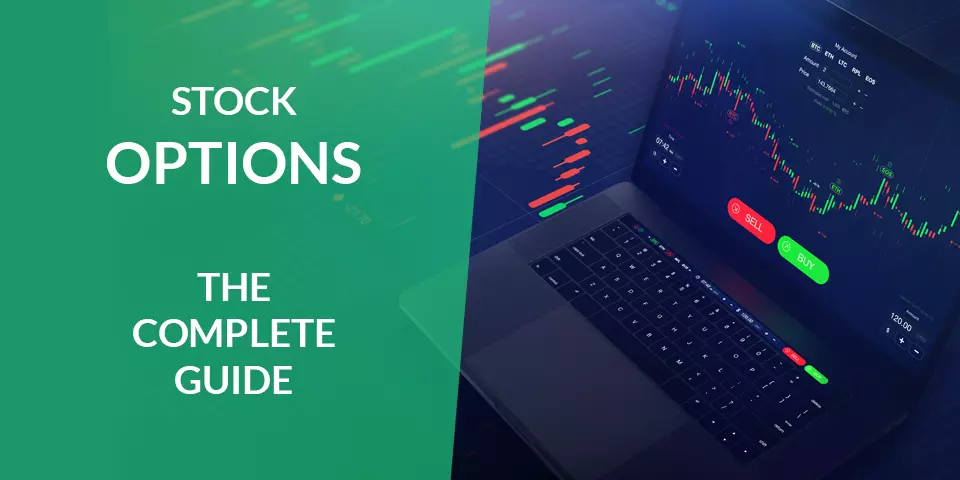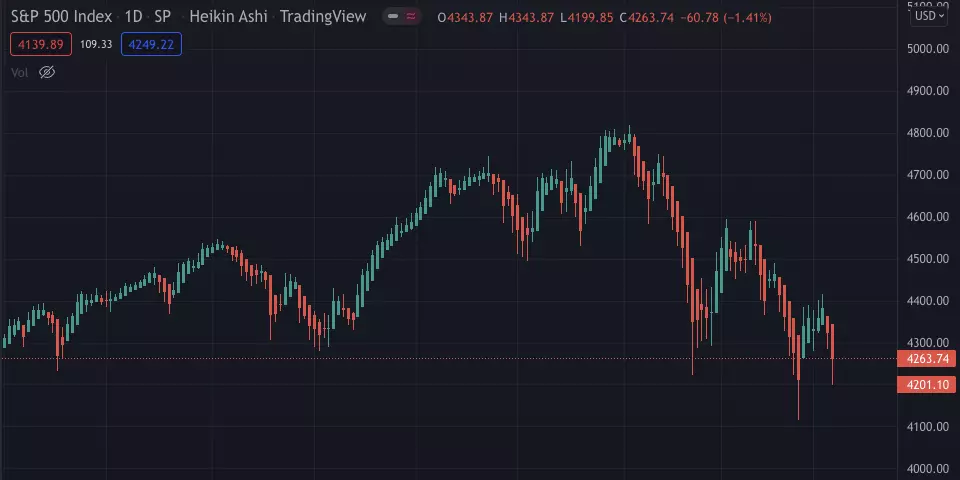I've stayed away from options contracts for a very long time, thinking they are just too risky and too expensive. The truth is, options can be very risky if you don't understand how they work. Once I took the courage to study the various ways to trade options and the more I understood them, my opinions have completely changed.
If you've had the same sentiment, you came to the right place. I will explain what options contracts are and how they work, then I will show you why they are such an amazing tool for making more profits in the markets.
Risk Disclaimer: Options trading involves considerable risk and is not suitable for all investors. There is a high risk to lose the entire investment within a relatively short period of time. Please make sure you are willing to take this risk before deciding to trade options.- What is an Option
- Buying Call Options Example
- Buying Put Options Example
- Options Price Anatomy and Terminologies
- Shorting Options Introduction
- Selling Covered Calls
- Selling Cash Secured Puts
- Advanced Options Concepts
- Bonus Options Strategy: The Wheel Strategy
- Tips when Trading Options
- Where can I trade options in the UK?
- The Bottom Line
What is an Option?
An option is a contract that gives the owner the right, but not the obligation, to buy or sell the underlying asset at the agreed price (referred to as the strike price) on or before a certain expiration date. To purchase an option, the buyer must pay a premium.
There are two types of options:
- Call options will give the buyer the option to buy the underlying asset at the specified strike price. In this case, the seller of the option will be obligated to sell the asset at the agreed price if the buyer decides to exercise the option before or after the expiration date.
- Put options will give the buyer the option to sell the underlying asset at the specified strike price. In this case, the seller of the option will be obligated to buy the asset at the agreed price if the buyer decides to exercise the option before or after the expiration date.
It is very easy to confuse the terms whether you buy or sell options with their respective type. As options are a contractual agreement between two parties, it may be easier to refer to buying options as "signing the contract" and selling options as "writing the contract".
Another thing to note is that stock options contracts often come in a bundle of 100 shares, but this value may be adjusted in a few special cases. Make sure you are always multiplying the costs by this amount when doing the calculations.
Buying Call Options Example
As a basic example, let's say you are willing to buy one call option on Apple stock as you think the price may rise in one month. We'll assume that Apple is trading at around $150 and you choose a strike price of $150 with a one-month expiration date for your call option contract.
Say the cost for that option would be $5, this means you will have to pay $500 in premium for this contract ($5 * 100 shares). Remember this option contract will give you the right to buy 100 Apple shares in the course of one month at $150 if you wish to do so.
Now let's say that after one month, on the option's expiration date, Apple is trading around $200 per share. Seeing the price increased as you anticipated, you decide to exercise your right to purchase 100 shares of Apple at $150 (the agreed strike price). You now have two options, you can keep the shares that you bought at a lower price, or sell the shares immediately at the current price of $200 per share and make a profit.
For a quick profit calculation, when you exercised the option, you paid $15,000 for the 100 Apple shares ($150 x 100) and you sold the shares for $20,000 ($200 x 100). Your profit from the option is $5,000 ($20,000 – $15,000), minus the $500 premium paid for the option, making you $4,500 net profit ($5,000 – $500). This makes it a very nice return of investment by only risking just the $500 paid for the option premium.
Risks when Buying Call Options
When buying call options your maximum risk is the premium you paid for the option if the option expires worthless. The option expires worthless when the stock price is below the option's strike price at expiration. If the option expires worthless, you don't have to do anything as it will simply disappear from your account.
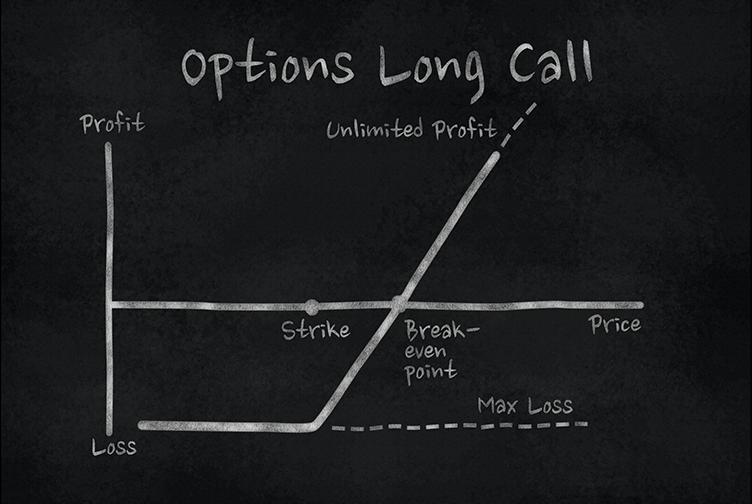
As you can see in the profit graph above, you need the stock price to increase above the break-even point or you will lose money from that trade. The break-even point is the strike price of the option, plus the premium you paid.
Benefits of Buying Call Options vs Buying Shares
- Call options will offer you downside protection as if the stock prices go to zero, you will only lose the premium you paid for the option. If you have owned the shares instead, you would have lost 100% of the money.
- They provide leveraged returns. Meaning that you will be able to have a similar position to a stock position, but at a much lower cost. It also means that you have higher percentage returns.
Buying Put Options Example
If you understood the above example when buying a call option, this will be much simpler to understand as put options are the exact opposite. When you are buying put options, you essentially think that the stock price will go down in a certain period of time as the option gives you the right to sell 100 shares of stock at the option's strike price.
For example, when owning 100 shares of Apple and buying a put option, as the price of the stock falls, the option's value increases as you have the right to sell the shares you own at a higher price than what it's currently trading.
Risks when Buying Put Options
When buying put options, your maximum risk is still the premium you have paid for the option if the option expires worthless. The put option expires worthless when the stock price is above the option's strike price at expiration.
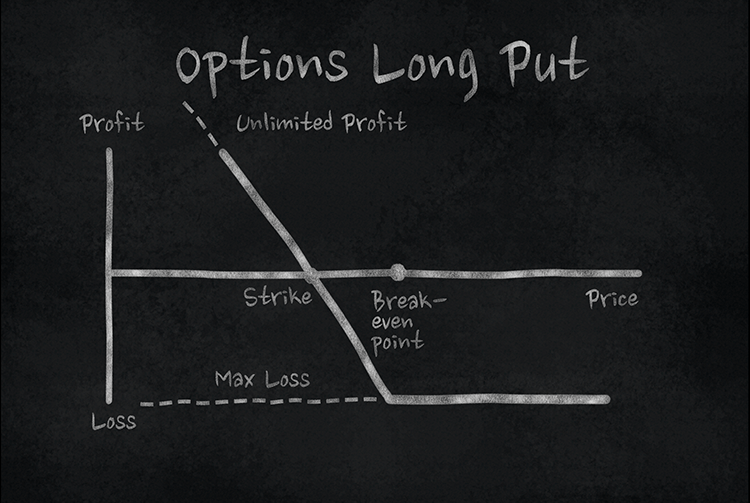
As you can see in the profit graph above, you need the stock price to decrease below the break-even point or you will lose money from that trade. The break-even point is the strike price of the option, minus the premium you paid.
Benefits of Buying Put Options vs Shorting Stock
The main benefit of buying put options instead of shorting shares is that they offer you greater protection in case the stock price goes up in value. This makes them safer than shorting the stock.
If you short the stock, you are exposed to unlimited risk as opposed to buying put options, you cannot lose more than the premium you paid for the option as it will expire worthless if the stock price will be higher than the strike price at expiration.
You can think of buying options as buying insurance, the premium you pay can be regarded as the fee you pay the insurance provider for the reassurance they offer you.
Options Price Anatomy and Terminologies
Before going into the other ways to trade options, let's explore the main components of an option's price and the various terminologies you should know when trading options.
Intrinsic / Extrinsic Value
Where does the option's price come from? The option's price, known as premium, is determined by the intrinsic and extrinsic value sum.
An option's intrinsic value is the difference between the current value of the underlying asset and the option's strike price.
In other words, let's say you have an "in the money" call option for Apple stock at a $150 strike price and the current price of the stock is at $200, you can say that the option has an intrinsic value of $50 as the call option allows you to purchase 100 shares of Apple at $150 which is $50 lower than the current market price.
An option's extrinsic value is the amount that exceeds the option's intrinsic value. It is also referred to as time value and represents the potential of the option to become more valuable with time before expiration.
In simpler terms, going back to our Apple call option example, say you are willing to buy an "at the money" call option at a $150 strike price with one month expiration date. As the current price is trading at $150 per share, the intrinsic value of this option would be $0, but you see the option is priced at $5.
This is because the option still has 30 days to expiration, giving the stock a long time potential to move in the right direction and to increase in price, making the option more valuable. For this time privilege, the option would cost $5 (or $500 premium) which consists of the extrinsic value of that option.
Time Decay
One important concept to understand is time decay. As you can see in the example above, options that have a lot of time left to expiration have more extrinsic value, but as the option gets closer to expiration, there is not much extrinsic value left because there's not enough time for the stock price to move and become intrinsically valuable.
This means that you buy that Apple call option at a $150 strike price with 30 days expiration and paid a $500 premium. If you hold it close until expiration and if Apple continues to trade at $150 you would lose $500 simply because of the passage of time as the premium had 100% extrinsic time value.
In the money, Out of the money, At the money
You may have noticed the terms: "In the money" (ITM), "Out of the money" (OTM), and "At the money" (ATM). These terms describe if an option has intrinsic value or extrinsic value.
In the money means the option has intrinsic value. For ITM calls, the stock price is above the strike price and for ITM puts, the stock price is below the strike price.
Out of the money is the opposite of ITM and it means that the option does not have an intrinsic value. In this case, the option only has an extrinsic value in its price. For OTM calls, the stock price is below the strike price and for OTM puts, the stock price is above the strike price.
At the money refers to an option with the strike price very close to the current stock price.
Shorting Options Introduction
As you've seen in the previous chapter, when buying call or put options and the stock price does not move until expiration, you will lose money due to the decay of the option's extrinsic value or time value.
Selling (writing) options strategy benefits mainly from the time decay where you profit from the loss of an option's extrinsic value as time passes and the option approaches the expiration date.
Think of this strategy as selling insurance. Investors often buy options as a hedge against unexpected price movements. You can leverage this when you have high confidence in the stocks you are holding and make some extra income.
Using this tool, you can boost your portfolio by having a steady passive income while you wait for the stock to hit a certain level (when selling cash-secured puts), or while holding the shares in your account (when selling covered calls).
Selling Covered Calls
The reason to sell call options is when you think the stock price is going lower or remains flat and you don't mind selling the shares you currently own.
When you sell (write) a call option you agree to sell the stock at the agreed strike price. Instead of selling shares, you can control the price where you'd like to sell those shares whilst collecting a nice premium in the process.
As you will be obligated to sell the stock at the option's strike price, the main requirement for you to be able to sell call options is by locking 100 shares of that stock as collateral. This is also referred to as a covered call.
A good tip here would be is to sell OTM (out of the money) covered calls to have a lower probability of losing the shares and collect the premium in the form of extrinsic value and profit from the time decay as explained in the previous chapter. This way you can constantly get an income while keeping your shares in your portfolio.
Risks when Selling Call Options
Selling call options involves an incredible risk as there is no upper limit that the stock price can reach. This strategy theoretically has unlimited risk.
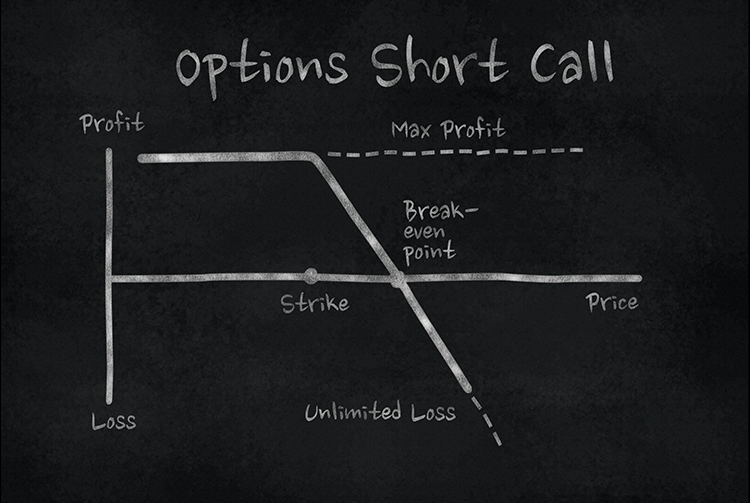
Since we know that by selling a covered call you agree to sell 100 shares of the stock at the agreed strike price, provided that you set the strike price above your stock's cost basis (above the average you paid for those shares), the risk is just losing the shares you have offered as collateral and losing the opportunity to make more money if the stock goes higher. In this case, you will still make a profit from selling the shares but not as much as you could have made.
As the risk is more of an "opportunity" risk, you can use this to your advantage and sell covered calls to control the price where you'd like to sell your shares, whilst making a passive income by also collecting steady premiums if the stock remains flat, increasing your returns over time.
There's also the risk for the stock price to go to zero, but in this case, you would have the premium you collected to offset the losses.
Selling Cash Secured Puts
The best reason to sell a put option is when you think the stock price will go up in the future and would like to own a stock at a lower price than it's currently trading.
When you sell (write) a put option you agree to buy the stock at the agreed strike price. Instead of buying shares, you can control the price where you'd like to purchase those shares and also collect the premium by doing so.
As you will be obligated to buy the stock at the option's strike price, the main requirement for you to be able to sell put options is by depositing the full amount for the cost of 100 shares of that stock at that strike price as collateral. This is also referred to as a cash-secured put.
How Warren Buffet made millions selling puts
This strategy was also preferred by Warren Buffet and there's no better example selling puts out there than how he did it.
A few years ago when Coca-Cola was trading at around $39, but around that time Buffet wanted to buy them for $35.
Instead of waiting for Coca-Cola's stock price to go lower, Buffet decided to sell 50,000 puts with a $35 strike price. As you know by now that each option contract is for 100 shares, he essentially agreed to buy 5 million Coca Cola shares at his desired price of $35.
After the deal was made, these 50,000 put contracts offered a $1.50 premium netting Buffet $7.5 million in cash.
Risks when Selling Put Options
I showed you the great rewards, but you also need to be aware of the risks. When you are selling puts, the maximum risk would be losing the entire collateral you put down for the option as you can see in the graph below.
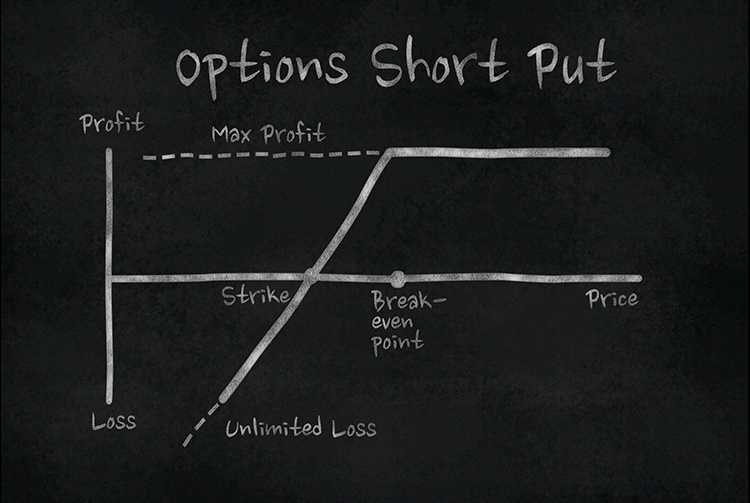
You need to be aware that there's always the possibility for the company's price to go to zero and you will be obligated to buy the shares at the agreed strike price however, you have the exact same risk as if you have bought the shares. At least by selling options you would lose less as you would still have the premium you collected.
Another disadvantage or risk with selling puts is that the maximum profit you can get is the premium you collected. If the stock price goes up you risk missing out on the opportunity to make more money.
As you can see, the risk of selling options is fairly similar to buying shares, except for this time you will have the benefit of picking the price you want and collect a nice premium for the privilege of owning stock in the company you like.
Advanced Options Concepts
Up to this point, we have gone through the four basic strategies for trading options, what are the main components of an option, and how time plays a very important role in the option's pricing.
In this chapter, I will go a little bit more in-depth and tell you about a few more advanced options concepts.
Implied Volatility
What is an option's implied volatility? An option's implied volatility or IV is essentially the expected degree of a stock's price changes in the future.
The implied volatility is another important metric when determining the option's price. Options that have high levels of implied volatility will also have high premiums. The reason for this is that if the stock price is expected to be volatile, it also means that there is a higher likelihood for the option to be more intrinsically valuable in a shorter amount of time, making time more valuable.
Another good thing to remember is that implied volatility is affected by the price action in the options market as when there are more buyers and the bid price goes up, the implied volatility will also increase.
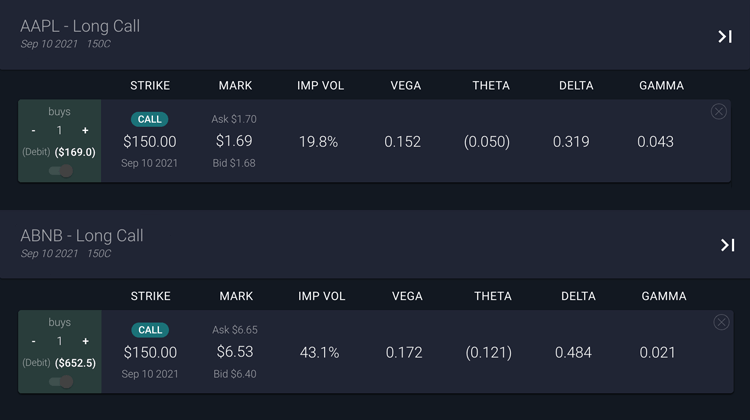
As you can see in the example above, I picked two stocks with a similar price and chose the same expiration date and the same strike price. Apple has an implied volatility of 19.8% with a premium cost of $1.69 and Airbnb has an implied volatility of 43% with a premium cost of $6.53.
As Airbnb stock is expected to be more volatile, the option premium cost is almost 4 times more expensive than Apple because the market expects larger stock price movements for Airbnb in those 30 days till expiration.
The Options Greeks
What are the options greeks? The options greeks are a set of risk and price measures named after the Greek letters that represent them and indicate how sensitive is the option to the stock price movements, changes in implied volatility, and time decay.
The four main Greeks are delta, theta, gamma, and vega.
Delta
Delta measures the impact of a change in the stock price. For example, an option with a delta of 0.30 means that the option's price will move with $0.30 for every $1 move in the stock price.
Delta is also commonly used to determine the probability of an option to be in the money at expiration. For example, an out-of-the-money option with a 0.30 delta will have around a 30% chance to be in the money at expiration and a deep-in-the-money option with a 0.90 delta will have a 90% chance to remain in the money at expiration.
Theta
Theta measures the time decay in the value of an option. As time passes, the chance for the option to be in the money decreases. As the expiration date approaches, theta tends to accelerate as there's less time left for the stock price to move in the money.
Gamma
Gamma measures the change in delta over time. This value is used to provide traders a better idea of what to expect in the future.
For example, let's say two options have the same delta but different gamma values. The option with the higher gamma is riskier as this means the option tends to have higher volatility making it more unpredictable.
Vega
Vega measures the risk of changes in implied volatility of the stock price. Higher volatility makes options more expensive as there's a higher chance for the stock price to be in the money at some point.
Rolling Options
The action of rolling options involves closing the current option contract and opening a different contract of the same category (call or put) at the same time.
The new option can be rolled in four ways:
- Rolled out - by moving the expiration date further out in the future.
- Rolled up - by choosing a higher strike price
- Rolled down - by choosing a lower strike price
- Combination of both - by choosing different expiration date and strike price
An option rollout is often preferred around expiration to avoid assignment on "in the money" options to continue to generate income or to adjust an existing position if you think the circumstances have changed for the underlying stock.
The most common options strategies where you may consider a rollout is when you are selling covered calls or cash-secured puts.
Volume and Open Interest
When you are trading options, you generally want to look for options that are more active or that have higher liquidity. This means that not only you be able to buy or sell the options faster, but also getting a better price as the bid/ask spread will be much tighter.
Open interest is the number of open contracts between two parties. More open interest tells you how popular a market is and how many traders are interested in buying or selling options.
Options Chain
When you are looking to trade options, the brokers will show you the options chain.
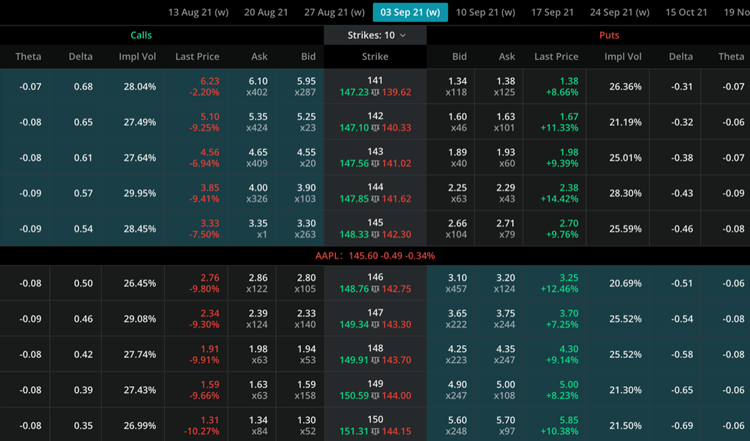
The options chain will contain all the information you need for both Call and Put options. You can see the strike prices in the middle column and the current stock price in the middle row. The rows highlighted in blue are the "In the money" options and the ones outside are the "Out of the money" options. You can also choose the expiration date by switching the tabs on the top of this chain.
The options chain often contains additional useful information such as the greeks, and you can customize this to display them as you like. In the image above, along with the bid/ask prices we can also see the implied volatility, the current delta, and the theta value.
Placing an order is as simple as clicking on the option at the preferred strike price and choosing the quantity and the option price within the bid/ask range. A price in the middle of the range may give a better chance for your order to be fulfilled.
Bonus Options Strategy: The Wheel Strategy
One options strategy I love very much is called "The Wheel Strategy". It involves selling cash-secured puts and covered calls repeatedly in a loop, hence the name.
- You start by selling cash-secured puts for a stock you don't mind owning 100 shares.
- If the option does not get assigned, you will repeat the first step until the option expires in the money and you get 100 shares of that stock. Make sure you keep track of your cost basis, by subtracting the premium you collected from the strike price.
- When you get assigned (and you will eventually), then you start selling covered calls with an out-of-the-money strike price, ideally above your cost basis.
- If the option doesn't get assigned then you repeat the third step until you get assigned. To avoid assignment and to not lose those shares you could try rolling the option. It is best if you can roll the option without going too far out with the expiration date. You will eventually get assigned and when you do, you go back to step one to sell cash-secured puts.
I like to keep a short expiration date of around 1-2 weeks and have a delta of 0.30 or under meaning, I will have around a 30% chance to be assigned. Sometimes I would choose a strike price closer to the stock price if I really want the shares at that price.
By doing this strategy, you will have a steady passive income that offers a return greater than any dividends out there.
You could also use this strategy with dividend-paying stocks and boost the income even more however, make sure you don't sell covered calls in the week on the stock's ex-dividend date as you have the risk of getting assigned and losing the shares right before you are eligible to collect the dividends.
Tips when Trading Options
Here are a few useful tips for you to remember:
- When selling options, try to find a strike price that has a low probability to get in the money and avoid being assigned. Usually, look for a delta lower than 0.30 giving a 30% chance to be ITM.
- If you have near max profit before expiration, you should close the option. It is not worth taking the risk for the price to go in the money and for the option to lose value. The risk to reward ratio is getting worse as the profit on the option increases. E.g. if you have sold an option for a $100 premium and it gets to $5 before expiration, you would have made a $95 profit, but you still have all the risk for the stock price to move against you.
- Rolling the options is a great way to avoid assignment if the stock price approaches your option's strike price. Make sure you don't over-extend this as sometimes it's not worth blocking your capital for a long time just for gaining a small premium.
- Remember to not sell covered calls when a stock's ex-dividend date is in that week as you risk early assignment and lose the shares.
- The best time to sell puts is when a stock's price drops in value after a sudden event or unexpected news in the market. In this case, the implied volatility of the option also increases making the option premium more expensive.
- Don't sell options before earnings dates. I've made this mistake so you don't make it. The stock may drop considerably after bad earnings, so please make sure you really want to buy that stock at the strike price in case of a dip.
Where can I trade options in the UK?
Now that you have learned about various terms and strategies, you should look for a good broker for you to start trading options.
I have to admit there are not many good brokers to trade options in the UK. Unfortunately, the best brokers I've seen for trading options were mostly based in the US ( e.g. Robinhood, Webull ) however, after trying out a few of the brokers available in the UK, I have decided to stick with just two: Interactive Brokers and Tastyworks.
If you decide to open an Interactive Brokers or Tastyworks account, you could support me by using my referral links below:
Interactive Brokers (Worldwide): https://ibkr.com/referral/valjohannes232 - If you sign up using this link you will get $1 in IBKR shares for every $100 of cash for up to $1000 worth of IBKR shares. The average balance must be maintained for at least 1 year for the shares to vest and be accessible.
Tastyworks (Worldwide): https://start.tastyworks.com/#/login?...
The Bottom Line
If you've come thus far, congratulations! There are many things to learn about options contracts and how they work. I encourage you to go study them in more detail and with time, you will be surprised how often you use them.
Options are complex instruments and they can be intimidating especially in the beginning, but once you understand them, they can be a very powerful tool.

